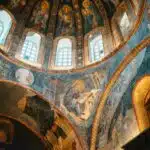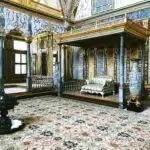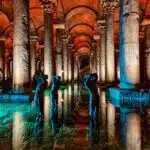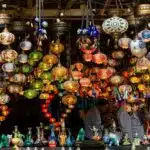Dolmabahçe Palace is a magnificent example of 19th-century Ottoman architecture, reflecting a blend of European and traditional Ottoman styles. Located along the Bosphorus Strait in Istanbul, it served as the administrative center of the Ottoman Empire from 1856 until its fall. The palace’s opulence and historical significance make it a must-visit attraction.



Must-See Highlights of Dolmabahçe Palace
- Palace Interior: The palace is famous for its lavish interior, adorned with crystal chandeliers, gold leaf, and ornate frescoes. The grand ceremonial halls, such as the Medhal Hall and the Crystal Staircase, showcase the exquisite artistry and craftsmanship of the time.
- Crystal Staircase: This unique staircase, made of Baccarat crystal, brass, and mahogany, is one of the highlights of the palace. Its elegant design and craftsmanship are truly stunning.
- Throne Room (Ceremonial Hall): The largest room in the palace, it features a massive 4.5-ton crystal chandelier, the largest Bohemian crystal chandelier in the world, gifted by Queen Victoria.
- Harem Section: The private quarters of the Sultan and his family, this section offers a glimpse into the personal lives of the Ottoman rulers, with richly decorated rooms and furnishings.
- Atatürk’s Room: The room where Mustafa Kemal Atatürk, the founder of the Republic of Turkey, spent his last days and passed away in 1938. It holds significant historical importance.
- Gardens and Grounds: The palace is surrounded by beautifully landscaped gardens and fountains, offering a peaceful escape with stunning views of the Bosphorus.
- Art Collection: The palace houses an impressive collection of European art, including paintings, sculptures, and decorative arts, showcasing the cultural influences during the late Ottoman period.


Tips for Visiting the Dolmabahçe Palace
- Timing: Arrive early in the day to avoid crowds, as the palace is a popular tourist destination. Guided tours are available and often provide more in-depth insights.
- Tickets: Purchase tickets in advance if possible, especially during peak tourist seasons. The palace can be visited only with guided tours, and entry to certain sections, like the Harem, requires additional tickets.
- Dress Code: While there is no strict dress code, modest attire is recommended as a sign of respect. Comfortable shoes are advisable due to the extensive walking involved.
- Photography: Photography is not allowed inside the palace buildings but is permitted in the gardens and exterior areas. Make sure to check specific restrictions on-site.
- Guided Tours: Opt for a guided tour to fully appreciate the history and significance of the palace. Audio guides are also available in multiple languages.
- Accessibility: The palace grounds are mostly accessible, but some areas may have steps or uneven surfaces, which could be challenging for visitors with mobility issues.
- Facilities: Restrooms and a café are available on-site for visitors. Take advantage of these facilities during your visit.
Dolmabahçe Palace offers a fascinating glimpse into the opulence of the Ottoman Empire and its transition into modern Turkey, making it a must-see for anyone visiting Istanbul.









